|
|
Tramp

|
|
 |
|
|
Tramp was a good four-mile horse who won a number of handicaps in the north of England, and became a popular sire there. His influence spread far beyond his Yorkshire home, however, since he sired five classic winners and two good sire sons, one of which, Lottery, continued the sire line for several generations. He also sired Trampoline, the dam of the influential broodmare sire -- on both sides of the Atlantic -- Glencoe. A number of Tramp's daughters produced classic winners and established tail-female lines that are thriving today. His sons also produced good daughters, notably Lottery, whose daughter, Rebecca, was the dam of the great Alice Hawthorn. Some of his sons and daughters, and some of their progeny, were racing or retiring from the turf in the 1830s, when private breeders in America, and the French government were shopping in England for fresh bloodlines, and so many of Tramp's progeny found some measure of success and a great deal of influence in both the U.S. and France, as well as England.
|
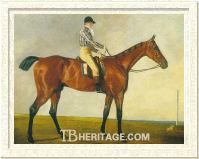
Dick Andrews
| |
Tramp's sire, the bay Dick Andrews (1797), was by Joe Andrews and out of a mare by Highflyer (1790); Joe Andrews was a good stayer who ran to the age of ten, winning four-mile heat races all over Yorkshire: York, Scarborough, Boroughbridge, Lichfield, and elsewhere. Dick Andrews was bred by a Mr. Lord; The Druid said, "In ugliness of ears, and head altogether, he was unrivalled; and so light was he in the body , as to require very little training." He was somewhat narrow, with a very long head and body. He was purchased by Major "Jemmy" Rooke, who also briefly managed his sire, Joe Andrews (named after a contemporary prize-fighter), who was used extensively by Yorkshire breeders, both on thoroughbred and non-thoroughbred mares. |
In 1800, age three, Dick Andrews won a sweepstakes at Chester, and four-mile heat races at Manchester and Newton-le-Willows, and ran second to Cinnamon at Nottingham in the Members' Plate, and third to Baron Nile and Robin Red-breast in a two mile sweepstakes at Lichfield, beating the good race mare Hyale and seven others. He beat Bobtail at Newmarket in 1802. He was sold to Viscount Charles Sackville-Germain (who also owned Manuella by Dick Andrews), and in 1803, he won a King's Plate at Newmarket, beating three horses, including the good racemare Eleanor, a sweepstakes at Newmarket in which he beat Bobtail, and a match against the 1801 St. Leger winner Quiz. In 1806 he beat Haphazard for a Ladies' Purse at Lewes, and ran second to Penelope in the Jockey Club Plate at Newmarket.
Dick Andrews was stout, sound, and relatively fast, all traits he passed on to Tramp, and to his other good offspring, which included Manuella (1809), who won the Oaks; her sister, Altisidora (1810), who won the St. Leger, the 2,000 Guineas winner Cwrw (1809), the good stayer Biddick, who won the Newcastle Cup and ran second in a number of other good handicap races
Tramp's dam was a mare by Gohanna, bred in 1803 by Lord Egremont. She apparently did not race, because she was put in the stud in 1807, and produced a colt, Scamp, a good runner, by Bobtail in 1808. She entered the Bishop Burton stud of Richard Watt that year, breeding seven foals for him (three of which died), after which she produced three more live foals for other Yorkshire breeders. Tramp was her third foal, born in 1810, by Dick Andrews.
She produced another good youngster for Watt in Beggar Girl (1815), a bay filly by Thunderbolt. At age three Beggar Girl won the Barton Stakes at Malton, beating four other horses, and a sweepstakes at York. She did not place in Reveller's St. Leger, and a few days later ran third of four in a sweepstakes over the St. Leger course, won by the good filly Eleanor. The next season she came out with a new name, Bigottini. She ran second in the Craven Stakes at Malton and the Craven Stakes at Catterick Bridge, but failed to place in her next three races. Beggar Girl/Bigottini was then sold to Lord Sligo and sent to his stud in Ireland, where she produced a number of decent runners; a daughter, Brandy Bet (1829, by Canteen) was the dam of Cruiskeen, the first winner of the Cesarewitch Stakes handicap in 1839. A great many stakes winners and some classic winners descend in tail-female from Tramp's and Beggar Girl's dam (Family 3).
The grandson of a long-time Yorkshire stud groom who had worked for a long time at John Hutchinson's stud at Shipton, near York, recounted Tramp's birth and the reason for his name: "Tramp was foaled out in a paddock during the daytime at Bishop Burton and no one associated with the dam was aware of what had happened. A tramp passing along the road saw the foal and forthwith went to the hall and informed the owner, Mr. Watt, who, owing to the circumstances called the youngster Tramp." He was a narrow youngster, but eventually filled out, reaching 15.2 hands, with a long, straight back and somewhat short legs, gradually becoming, said The Druid, "one of the grandest-boned and grandest-looking horses in England..." He was never a very kind horse, and became increasingly vicious in temperament as the years wore on.
Tramp on the Turf
Tramp was put in training with "Old" Sykes, at Langton, near Malton, who also trained the Dick Andrews classic-winning daughter Altisidora, Tom Tit, Blacklock, and other horses for Watt; except for the Doncaster Cup, he was ridden in all his races by the famous Yorkshire jockey John Jackson. Tramp started his two-season career at age three in 1813, when he won two sweepstakes over one mile at Malton for three year olds, and went on to win a 1-1/2 mile race the next day against two opponents. Two months later he won a sweepstakes for three year olds at Beverley over 1-1/2 miles, beating Prime Minister, and others. He lost his last two races, a mile 300 guineas match at York August meeting against the mare Dulcinea, and a one mile sweepstakes at Pontefract in September, won by Don Carlos.
In his next -- and last -- season, at age four, he proved to be a top stayer and successful runner, the stoutest horse of his era. He started by winning the Gold Cup at York Spring Meeting over two miles, beating three horses in a race which excited a great deal of betting action. At Beverley, in May, he won the Gold Cup over four miles, beating two others, and the same day won a plate in two three mile heats. At York August Meeting he ran second in the Great Subscription Purse, beaten by a neck by Prime Minister in a hard-fought race, the other two horses -- Hocus Pocus and Camelopard well distanced. In September, at Pontefract, he won the Gold Cup over four miles, beating XYZ and the good race mare Marciana. Two weeks later, at Doncaster, he was barely beaten by Catton in the Fitzwilliam Stakes over 1-1/2 miles, the remaining three horses in the race barely in the running. The next day he had an easy win in the Prince's Stake for four year olds over four miles, beating four others, including Hocus Pocus, Molyneaux, and Don Carlos. He ran again, for the third straight day in a row, in the Doncaster Gold Cup (then over 4 miles) carrying 140 lbs, which he won easily, beating three others.
Watt had planned to run Tramp another season, but he developed wind problems while in training, and he was retired to stud.
Tramp in the Stud
Tramp began his stud career at Bishop Burton, where he stood for 10-1/2 guineas in 1816; Watt dropped his fee to 5-1/2 guineas for the 1817-18 season, and then, upon retiring Blacklock to his stud, sold Tramp to George Sheffield Merrington for 400 guineas. Merrington sent Tramp to Bevereley for the 1819-1821 seasons at a fee of 5-1/2 guineas, then, with Tramp's youngsters staring to show such great promise on the turf, Merrington made a tidy profit by selling Tramp to Frederick Lumley for 1600 guineas. Tramp stood at Lumley's Tickhill Castle Farm for eight years, where he covered at 15 guineas. In 1830 he was sold for 800 guineas to gambler Robert Ridsdale, who had established a well-appointed stud at Murton, near York, and where he was used primarily as a private stallion on Ridsdale's own mares. In the spring of 1835 he was given to John Newton of Howe Bridge, near Malton, where he successfully covered eight mares. In December, somewhat crippled and increasingly dangerous to manage, he was led to a grave dug for him at Howe Bridge Farm, and shot. An old stud groom who had seen all the stallions of that era in Yorkshire said that, of all the sires he knew, "...not one ever sired sounder or hardier stock" than Tramp.
Tramp sired two One Thousand Guineas winners, Charlotte West and Tarantella, and another good filly, the stayer Ballad-Singer. His daughters produced three English classic winners and two French Derby winners, and the influential broodmare sire, Glencoe, was out of a Tramp daughter. Tramp also got the Derby winners St. Giles and Dangerous, and St. Leger winner Barefoot, only the latter having any impact on the breed through some daughters bred in the U.S. He also sired Lottery, a good stayer, who continued the sire line and also got some good daughters, notably Rebecca, the dam of Alice Hawthorn. Another Tramp son, Liverpool, sired 2,000 Guineas winner Idas, and the very good horse Lanercost, who got some good horses, including Oaks winner Catherine Hayes. Tramp had an influence on both American and French thoroughbred lines through his sons and daughters, the latter including Glencoe's dam, Trampoline, who were running and breeding in the 1830s, when both the French and the Americans were looking to England for bloodstock to rejuvenate their bloodlines.
|
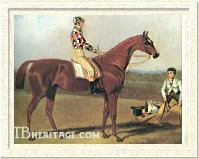
Barefoot
| |
The chestnut BAREFOOT was bred by Richard Watt, from Rosamond, by Buzzard, in 1820. He was Tramp's first classic winner. Rosamond (1798), a chestnut whose grandam, Miss West (by Matchem) had been bred at Bishop Burton by its previous owner, Richard Gee in 1777. Rosamond was bred by Watt's racing associate, Gilbert Crompton, and was sold to Lord Grosvenor, for whom she ran third to Penelope (dam of Whalebone) in a race at Newmarket, and placed second to Eleanor (dam of Muley) in the Oaks in 1801. She returned to Crompton's stud where she produced seventeen foals between 1804 and 1824. Barefoot was her fourteenth foal; his year-older sister, Marion, won at York for Watt, and was later a producer, and several other of Rosamond's youngsters won races in the north, including another full sister to Barefoot and Marion, Tramper, but Barefoot was her best. |
Barefoot ran for six seasons, 1822 through 1826, and like Tramp, was a stayer. At age two he started his career by running second in a sweepstakes for two year olds at York, beaten by the Walton filly Miss Fanny. He won his next race, for two year olds at Pontefract, beating five other youngsters.
At age three he won the St. Leger Stakes at York in the spring, and in August, again at York, won a sweep for 250 guineas beating Conductor and three others. He then won a race at Pontefract. His next race, the Doncaster St. Leger, was not atypical for the period; twenty-seven horses started, and after three false starts, twenty-three of them left the post, and despite being called back, ran the entire race, won by a Comus colt, Carnival, with Barefoot second. When this was declared a false start, fifteen horses who had already run the distance were withdrawn, including Watt's Lottery (then named Tinker), so the final running encompassed a much smaller field, eight of whom had already run the race once. Barefoot won this second running easily by two lengths. After this display of stoutness, Barefoot was purchased by William Henry Vane, the Earl of Darlington (in 1827 1st Duke of Cleveland), who sent him to Newmarket, where he won a 50 sovereign purse over six other horses at the Houghton meeting. Two years later, in 1825, Darlington would purchase another Watt-bred St. Leger winner, Memnon (Whisker-Manuella) after that race for £3,500, but it wasn't until 1831 he actually ran a St. Leger winner, the Lottery son, Chorister.
In 1824, age four, Barefoot walked-over for the Swinley Stakes at Ascot. He then ran second to Bizarre, an Orville colt, in the Ascot Gold Cup over two and one-half miles. Back at Doncaster he ran third in a King's Plate (four miles), and then ran second to his former stable mate, Lottery, in a sweepstakes held over the St. Leger course. The following year, age five, he won the Lancaster Gold Cup (3 miles), beating Lottery and two others. He ran third for the Cup at Derby, and second for the Darlington Cup at Wolverhampton over three miles. He then ran second for the Northallerton Cup. In 1826 he won the Lancaster Cup again, and also a race at Manchester. He ran second for the Cup at Stockton, beaten by a Waxy Pope son, Canteen, and then ran unplaced twice, including the Craven Stakes at Catterick.
Darlington sold Barefoot in 1828 to Admiral Sir Isaac Coffin (1739-1839), a British loyalist who had left the U.S. after the Revolution and had served in the British navy during the Napoleonic wars. Coffin sent Barefoot and another horse he purchased from Darlington, Sarab, to Boston. Barefoot stood at Brighton, near Boston for two years, then went on to New York for three years before returning to Brighton. He was not well-supported in the North, and was sent to Virginia, returning to New York for several years before going to Louisville in 1837-40, ending his days at David Morrison's stud in Tipton County, Tennessee, in 1840, dying of a snake bite.
He was a pretty much a dud as a stallion; like most imported stallions from that period, his offspring were far overshadowed on the turf by the sons and daughters of Sir Archy, and the offspring of Sir Archy's sons, such as Sumpter, Bertrand, and Timoleon. His first winners on the track were in 1834-35 -- two winners of three races, compared to the Sir Archy son, Bertrand's, 23 winners of 30 races -- and the number of winners he had in any one year never exceeded five. However, except for imported Leviathan, and later, briefly, imported Luzborough, few stallions imported in the 1820s and early '30s did any better in regards to number of winners, compared with the juggernaut presence of Sir Archy and his sons.
In New York, Barefoot sired Tramp (1833, from Maid of the Mill by Duroc) and Ajax, "prominent in Long Island stables," and Clara Howard (1831, from the imported Alarm, by Thunderbolt), a top race mare of the 1830s, and Barefoot's only really good winner. Her grandaughter, Annie Bush (Lexington-Banner by Albion, bred at R.A. Alexander's Woodburn Farm in Kentucky), won the last Post Stakes, four mile heats, at the Metairie course in New Orleans; Annie Bush's son, Bushwhacker, was a famous racehorse of the 1870s, who won the final Great Long Island Stakes at Sheepshead Bay, the last four mile heat race ever held on a New York track.
Another daughter of Barefoot, Motto (1839, Lady Thompkins by American Eclipse), a foundation mare at Alexander's Woodburn Farm in Kentucky, was a good producer whose tail-female descendants included the top sire Commando; such good mid-to-late nineteenth century winners as August Belmont's great racemare Susquehanna (1874, winner of the Central, Kentucky, Hunter and Alabama Stakes, champion three year old filly) and her famous son Potomac (1890 Futurity and other top races, champion two year old colt); the Dwyer Brothers' Onondaga (1879); and a number of American classic winners and top handicap horses extending well into the 20th century.
|
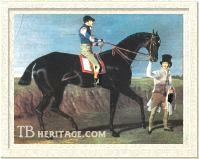
Lottery
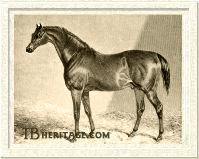
Liverpool
| |
LOTTERY, out of the great producer Mandane, was also born in 1820. He was an attractive 16 hand high horse with a dubious temperament, aggravated by mismanagement. He won eleven races in his four seasons on the turf, and ran second seven times. He was a great stayer who won at distances up to four miles, his triumphs included the Doncaster Cup, Lincoln Cup and York Cup. Many considered him the best of his generation.
Retired to stud in Yorkshire, he became a source of stamina: he got one classic winner, Chorister, who won the St. Leger. His son Sheet Anchor, who continued the Joe Andrews branch of the Eclipse sire line, had a brief career on the turf and at stud produced some good horses, mostly stayers. Lottery's daughter, Rebecca, became the dam of the great racemare, Alice Hawthorn, who was the dam of Derby winner Thormanby, and who became the tail-female ancestress of many top stakes winners. Two of his daughters, Heads or Tails and Frolicsome Fanny, the dam of the good racemare Nina (dam of Planet), became influential in American pedigrees. Lottery was sold to France in 1834, where he got some good winners. Lottery also had an influence on steeplechasing bloodlines in England, France and Ireland.
|
LIVERPOOL, also bred by Richard Watt at Bishop Burton, from a Whisker mare out of Mandane ( and so a close relative of Lottery), was born in 1828.
LIVERPOOL was a good, game stayer who ran against top company in his four seasons on the turf. He ran in Watt's harlequin colors as a two year old, placing fourth in a sweep for two year olds at Doncaster. He was sold at the end of his juvenile season to W. "Crutch" Robinson (a notorious bookmaker), who ran him during his three year old year; in that season he won a very fast Produce Stakes handicap at York over two miles, beating Tiberius and Creole (brother to Mulatto) and two others, and Doncaster's Gascoigne Stakes (two heats, the first a dead-heat), beating Chorister, who had won the Doncaster St. Leger in which Liverpool ran unplaced. Robinson then sold Liverpool to William Henry Vane (formerly the Earl of Darlington, now the 1st Duke of Cleveland), who owned Chorister. At age four he won the Port Stakes at Newmarket, a race at Knutsford, and took a walk-over at Doncaster. The next year he won the York Gold Cup and the Stanley Stakes, and ran second to Consul for the Preston Cup. After this, he was sold to John Ramshay and retired to his stud at Naworth Castle, near Carlisle.
LIVERPOOL'S son, Lanercost, out of Otis, by Bustard, was born in 1835. He was a very good stayer and weight-carrier, always running in top company, and later a sire of classic winners and many long-running, weight-carrying stayers. His sister, Otisina, became, through her daughter Hybla, the grandam of the 1854 Oaks winner, Mincemeat. Lanercost won twenty-two races and took four walk-overs during his four seasons on the turf, including the first running of the Cambridgeshire Stakes handicap, and the Ascot Gold Cup.
Lanercost's offspring included the two top colts of the 1844 generation, War Eagle and Von Tromp. The big, fast War Eagle, was second in the 1847 Derby and won the Doncaster Cup. The bad-tempered, but speedy Von Tromp, won three top juvenile races, and later won both the Liverpool and Doncaster St. Legers, the Goodwood Cup and the Emperor of Russia's Plate at Ascot, his last race. Von Tromp was sold to Czar Nicholas of Russia for 2,000 guineas, becoming a "great favorite."
Lanercost's daughter, Catherine Hayes (1850) was a beautifully-actioned, sweet-tempered mare who won the Oaks and Coronation Stakes at age three; she was later the dam of Ascot's New Stakes and Epsom's Woodcote Stakes winner Belladrum (1866). Another Lanercost daughter, Ellerdale (1844) won the Gimcrack Stakes and Park Hill Stakes at Doncaster, and the Great Yorkshire Stakes at York, and became the dam of Derby winner Ellington (1853) and Oaks winner Summerside (1856).
LIVERPOOL'S son, Idas, who was out of Pocahontas' dam, Marpessa, was a gentle 16 hand tall yellow bay horse. He won the 2,000 Guineas in 1845, had a walk-over for the Newmarket Stakes, and won Ascot's St. James' Palace Stakes, and ran second by a head to Jericho in the Grand Duke Miachael Stakes. Another LIVERPOOL son, A British Yeoman, won Doncaster's Champagne Stakes and Doncaster's Two Year Old Stakes at the same meeting, as well as winning or placing in a number of other sweepstakes in North Country venues as a juvenile. He did not place in Cotherstone's Derby, and ran once more, placing second in a sweep at Newcastle, after which he was retired to the stud near Carlisle and as a consequence, did not get many thoroughbred mares, although, The Druid said, "his hunters were superb."
Several of LIVERPOOL'S daughters were dams of notable horses. Espoir (1841, out of Lap Dog daughter Esperance), produced an excellent race filly, Brown Duchess, who won the Filly Stakes at Doncaster and Ascot's New Stakes as a juvenile, and at age three won the Epsom Oaks, the Yorkshire Oaks, Doncaster's Park Hill Stakes, and the Grand Duke Michael Stakes, and dead-heated with Kettledrum for the Doncaster Cup. Liverpool's daughter Jamaica (out of Preserve, by Emilius) produced the chestnut colt Yellow Jack (1853, by Birdcatcher), who became famous for losing good races by a head, or, at most a neck, including the 2,000 Guineas, the Epsom Derby, the Chester Cup, the Ascot Derby and the Goodwood Cup.
|
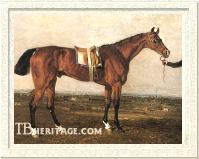
Zinganee
| |
Despite running third in the Derby of 1828, ZINGANEE was considered one of the best horses in England during his years on the turf. He was born in 1825, out of Folly, by Young Drone, and was bred in the Burghley House stud of Brownlow Cecil, 2nd Marquess and 11th Earl of Exeter, in Northamptonshire. He ran for the Earl at age two, unplaced in the July Stakes at Newmarket, then winning a small race at Stamford, beating the only other horse in it, the filly Ianthe. He then ran a respectable second to Merchant (who had won the Clearwell Stakes the day before) in Newmarket's Prendergast Stakes for two year olds, beating eleven other youngsters.
|
At the end of his juvenile season he was sold to the trainer-jockey brothers Will and Sam Chifney, and Sam, with the exception of a few races after Zinganee was sold, was his jockey throughout his career. At age three he ran third to the 1,000 Guineas winner Zoe and to Varro in Newmarket's Underley Stakes. He won his next race, the Newmarket Stakes, beating ten others. He ran "a good" third, "despite being amiss" in the Derby, where Cadland and The Colonel dead-heated (Cadland won the deciding heat). Zinganee did not run the rest of the season.
In 1829 he came out to win, by a short head after an "astounding" driving finish, the Craven Stakes at Newmarket, beating the aging racemare Fleur-de-Lis, Amphion, and six other good horses. At the same meeting he won the Claret Stakes, beating Derby winner Cadland and one other. He then went to Ascot, where he won the Oatlands, and then he was sold for £2,500 to George Stanhope, Earl Chesterfield on the evening before the Ascot Gold Cup, which he won by two lengths, beating a bunch of classic winners, including Mameluke, Cadland, The Colonel, Oaks winner Green Mantle, and the previous year's Gold Cup winner Bobadilla. With Sim Templeman up, Zinganee ran second in the Fitzwilliam Stakes at Doncaster (won by Tramp's son, Tyke), and ridden by William Arnull ran second in Newmarket's Audley End Stakes, won by Cadland; Arnull's management of Zinganee in this race was criticized and compared unfavorably with "what Chifney would have done." He was entered for the Doncaster Cup, but was injured and did not start, and was subsequently sold to King George IV.
In 1830 he was "not himself" for the entire year. He ran second to the Phantom filly Seraph, beaten by a neck, in Newmarket's Craven Stakes. With Chifney back in the saddle, and "...so recently ill that he could scarcely walk," he ran fourth and last for the Ascot Gold Cup, Chifney pulling him up one hundred yards from home, "trembling all over." At Goodwood he ran second to the grand old Fleur-de-Lis for the Cup in a field full of good horses. He was beaten for The Whip at Newmarket by Cadland, Zinganee, "in running reminded one of a fine old ship, sadly out of repair, badly manned and worst steered." After this season he was sold back to Chesterfield, who challenged for The Whip in 1831 at Newmarket's first spring meeting, and obtained it.
Zinganee was retired to Chesterfield's stud at Bretby Park, where the 1830 Derby winner Priam later joined him. His best offspring, in England, was Beggarman (1835), out of Adeline, by Soothsayer. He won the Goodwood Cup in 1840, beating Lanercost , Hetman Platoff, Charles XII and other good horses, and placed second in some good races, including the Newmarket Stakes. He passed through several hands, before being purchased in 1839 by the Duke of Orleans, who sent him to the continent where he won the Gold Cup at Boulogne and the Gold Cup at Brussels that year. In 1840 won two races and received a forfeit at venues in France before returning to England to contest at Goodwood.
Zinganee was purchased by Merritt & Co., bloodstock agents from the U.S., and was exported there in 1836. He sired six winners of eight races in America before dying there in 1841.
|
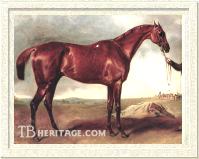
St. Giles
| |
ST. GILES, who was to become the subject of a great deal of controversy following his Derby win, was out of the Ardrossen daughter, Arcot Lass, and was bred by a Mr. Cattle in 1829. His half-brother, Derby winner Bloomsbury (1836, by Mulatto, owned by Robert Ridsdale's brother, William, or possibly Lord Chesterfield), later was also a focus of controversy. Arcot Lass was also the dam of the Tramp youngsters SCROGGINS (1833) and VACUNA (1834), both bred by George Stanhope, 6th Earl of Chesterfield; Scroggins was a fair racehorse who ran second to Elis in the 1836 Doncaster St. Leger for his owner-jockey William Scott. Vacuna was started second favorite, but unplaced, in the Oaks of 1837.
|
St. Giles was sold to the partnership of the gamblers Richard Ridsdale and John Gully, and seemed to be rather unpromising as a juvenile, failing to place against mediocre competition at a Newmarket race for two year old colts and fillies (won by Miss Mary Anne), and a handicap, also at Newmarket (won by Gratis, by Middleton).
He came out in 1832 winning a match against the more heavily weighted four year old filly Lioness at Newmarket Craven, and then won a handicap sweepstakes for two (actually three) year olds at the same meeting, beating five youngsters, most of which were unnamed. In the months preceding the Derby, odds on St. Giles winning the Derby were low, despite Ridsdale's confederate and partner in St. Giles' ownership, John Gully, purchasing Margrave for a large sum of 2500 guineas less than a month before the Derby, with the implication of some sort of Derby "management" pending. Margrave was a much more promising youngster than St. Giles, who at two had won several races in top company, including Newmarket's Criterion Stakes. In the last weeks before the Derby St. Giles gradually rose in the books, becoming third favorite to Margrave and Perion before the race started. St. Giles won the Derby, one of the fastest recorded to that time, after a number of false starts, over twenty-two other horses, including Beiram, Perion (second), and Trustee (third, also owned by Ridsdale), with Margrave running fourth "without ever being called upon." Ridsdale and Gully won a great deal of money in bets, as did another notorious bookmaker, William Crockford. After the race, Perion's supporters lodged an objection based on a slight error in St. Giles' entry, which listed Arcot Lass' dam as Floyerkin, rather than as "dam by Cramlington, out of Floyerkin." The matter was referred to Jockey Club stewards who ruled in favor of Ridsdale and his associates.
The next race for St. Giles was the Goodwood Cup, won by Priam, in which St. Giles ran unplaced. He did not run again until Glencoe's Goodwood Cup in 1834, where he again ran unplaced. After this race, he was sold to Thomas Kirby of York, after which he was again a winner, capturing the Craven Stakes at Catterick and a race at York, and running an honest third to Rockingham and Glaucus in his third try for the Goodwood Cup in 1835. St. Giles was sold to James Jackson and sent to his estate, Forks of the Cypress (where Glencoelater stood), in Alabama in the U.S., along with Lap Dog, the longshot 1826 Derby winner, in 1835. St. Giles spent the 1836 season at stud in Tennessee under the management of Colonel George Elliott, at the high fee of $50. Elliott also stood Leviathan (imported in 1830) for Jackson, and other stallions Jackson imported into the U.S. St. Giles died early, and did not leave much of note.
Ridsdale and Gully had a falling out in the year of St. Giles' Derby. Margrave, in Gully's ownership, went on to win the Doncaster St. Leger that year, and later also won Doncaster's Gascoigne Stakes, Newmarket's Grand Duke St. Michael Stakes, and ran second in the Newmarket St. Leger. Ridsdale was apparently dissatisfied with whatever agreement they had come to regarding bets placed on Margrave's win, and put about public comments regarding Gully which came to a head on a hunting field, where Gully took out his displeasure on Ridsdale by whipping him; Ridsdale took him to court in York for assault, and won a judgement against him. With the partnership dissolved in ill-will, Ridsdale's access to huge betting coups diminished, and by 1836 he lost all he had built, including his horses and his estate at Murton.
|
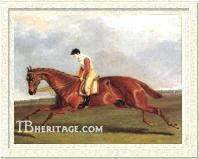
Dangerous
| |
DANGEROUS was an 1830 15.3 hand chestnut colt bred by Isaac Sadler, an Oxford livery stable owner who had stud farms at Northleach, near Cheltenham, and at Stockbridge. His dam, the Rubens daughter Defiance, bred by Sadler in 1816, also produced two sisters to Dangerous, Design (1827) and Device (1826) (see below), both of whom raced, a half-sister, Delight, by Reveller, who was a very good race filly, and a half-brother, Defence, by Whalebone, who became a good sire. Dangerous was described as having good bone, "rare quarters," and large and powerful. He had a truncated career on the turf, running for two years, and was sold for stud to France in 1835, where he made no mark as a sire.
|
Dangerous ran second in two races as a juvenile: the Sultan filly Minima beat him at Ascot in a sweep for two year old colts and fillies, and Glacus beat him in a sweepstakes at Stockbridge. He was not placed in a sweepstakes for two year olds at Warwick.
At age three he started out by winning the Derby, in a field of twenty-six. Lamed soon after, his condition was kept secret and he was able to walk-over for a 100 sovereign sweepstakes at Stockbridge and a produce sweepstakes at Winchester. Unable to train on, he entered the stud in 1834, and the following year he was sold to France.
|
Other Tramp sons: BAY BURTON, born in 1820 from a mare by Gabriel, bred by Richard Watt in 1799. He ran third in both the Oatlands Handicap and the Craven Stakes at Newmarket at age three, and won the Oatlands Handicap at Ascot. His dam produced three other Tramp colts, and one, an unnamed chestnut called "BROTHER TO BAY BURTON" won a plate at Catterick in 1824, beating a good northern runner, Springkell. TYKE, a chestnut colt of 1826 out of a Cervantes mare, was bred and mostly raced by Robert Ridsdale; he won Doncaster's Fitzwilliam Stakes at age three, and the Wiltshire Stakes and the Gold Cup at Salisbury, the Gold Cup at Blandford, and a King's Plate at Weymouth at age four, but died in a stable accident at the end of 1830. LITTLE RED ROVER (1827), a chestnut colt was out of the good producer Miss Syntax (also dam of Syntax, Scipio, and Guido), a sister to the Cup specialist Doctor Syntax (sire of Bee's Wing), and was bred by Robert Ridsdale. He was a "small but finely shaped colt" not quite 15 hands tall, with a racing career that lasted until age seven. He won seventeen races, and ran second by two lengths to Priam in the 1830 Epsom Derby, and third in 1831 in a race to Mazeppa and Keepsake at Bath. Through his daughter The Golden Horn, he was an ancestor of Derby winner Volodyovski, One Thousand Guineas winner Electra, the great staying mare Hammerkop, and other good winners, and through another daughter, grandsire of Buccaneer, grandsire of Loved One. VAGRANT (1828), from Ada, a Woful daughter, won a 100 sovereign race for three year olds at Newmarket. A number of other Tramp sons, some unnamed, won at Newmarket, Doncaster, and country venues.
Tramp's Daughters
Tramp got some good race fillies, the classiest probably Charlotte West, one of his two One Thousand Guineas winners. Many of his more successful racing daughters did not breed on, but he did get Trampoline, who ran second in the 1,000 Guineas and later produced the good racehorse and influential sire, Glencoe, who through his daughters had a great impact both in England and America. Tramp also sired Lady Stumps, who produced Oaks winner and Derby runner-up, Defence; 1,000 Guineas winner Tarantella, who became the dam of two French Derby winners; Fury, dam of Oaks winner Our Nell; and Lady Moore Carew, dam of the dual-classic winning filly Mendicant (later dam of Derby winner Beadsman).
CHARLOTTE WEST (1827) was out of the great producer Filagree. Filagree, who was by Soothsayer, had been bred by Lord Jersey, and she was retained in his stud, rewarding him by producing three classic winners -- Cobweb (1821, by Phantom) who won both the 1,000 Guineas and the Oaks; Riddlesworth (1828 by Emilius), who won the 2,000 Guineas, and Charlotte West, the only one of her many foals who was sired by Tramp. In addition to Charlotte's 1,000 Guineas win in 1830, she won the Royal Stakes at Ascot. She produced her first foal in 1833, for Sidney Herbert, which was accidentally killed. She did breed on, with a few winners descending from her in tail-female line.
TARANTELLA (1830) was out of John Cookes' mare, Katherine, a Soothsayer daughter bred by the 5th Duke of Rutland; Katherine was one of a number of good daughters out of the great producer Quadrille (Family 22). Katherine won Ascot's Albany Stakes for the Duke as a juvenile, and later was sold to Cookes, for whom she bred thirteen foals. Her daughter, Tarantella, had "a fine sweeping action" which won her the 1,000 Guineas, but she ran unplaced in Vespa's Epsom Oaks. Tarantella had several foals in England before her sale in 1840 to Auguste Lupin in France, for whom she bred Gambetto (1845 by Emilius) and Amalfi (1848 by Young Emilius), both of whom won the Prix du Jockey Club (French Derby).
|
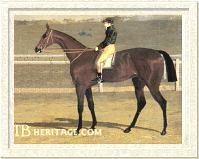
Ballad-Singer
| |
The bay Tramp filly BALLAD-SINGER was an out-and-out stayer, bred by William Wentworth Fitzwilliam, (2nd) Earl Fitzwilliam, in 1825 from his good broodmare Clinkerina, by Clinker. Clinkerina also produced the staying Comus son, Humphrey Clinker, who was the sire of both St. Leger winner Rockingham and of Melbourne, who carried on the Godolphin Arabian sire line. Ballad-Singer ran until age five. At age two she ran third to The Colonel in Doncaster's Champagne Stakes, and win £300 at York in August. In 1828, running under the ownership of Fitzwilliam's son, she did not place in the Doncaster St. Leger. In 1829 she won races at York and Doncaster, and the King's Plate at Lincoln, and in 1830 won the King's Plate at Lincoln again, King's Plates at York and Doncaster, and ran second to Laurel in a four mile race at Doncaster.
|
Retired to the grand Fitzwilliam Wentworth Woodhouse stud in Yorkshire, with its 100 box stable block, in 1830, Ballad-Singer produced six live foals, none of whom made much of a mark in the stud, although a son, Wentworth (1833 by Young Phantom) was sent to Germany. Ballad-Singer's sister, GIPSY, by Tramp, born in 1828, was sent directly to the Fitzwilliam stud. She had more success as a progenitress, with such tail-female descendants as the top French winner Barneveldt (1928, Grand Prix de Paris and others), and Gazala (1964, French Oaks) and Gazala's good sons, including the stayer Youth (1973, Prix du Jockey Club, Washington D.C. International Stakes).
MUTA (1819), Lottery's sister from Mandane, won the the Sapling Stakes and Produce Stakes at York. She produced a couple of sons who ran well in the north, Manchester and Gardham, but her line did not breed on in tail-female.
MARION (1819), a sister to Barefoot out of the Buzzard mare Rosamond, won a sweepstakes at York in August of her juvenile year for Richard Watt, and ran in, but did not place in the Doncaster St. Leger. She was put into the stud of Gilbert Crompton, an associate or Richard Watt's, and the breeder of her dam. Her sons Robin Hood (by Blacklock) and Napier (by Gladiator) were successful on the turf -- Robin Hood won the Newcastle Gold Cup twice, and three other north country Gold Cups -- and she was third dam of the French Oaks winner Lavant.
TRAMPLE (1825) was bred by George Armitage from a Smolensko mare. She was purchased by gambler John Gully, and at age two won Ascot's Albany Stakes and a King's Plate at Chelmsford; at age three she won a 200 sovereign match against the colt Kildare, and ran second in a sweep to Miss Craven at Goodwood. Purchased by Lord George Bentinck, she was used as a hunter for several years before being put in the stud in 1837; she was not a successful broodmare.
TRAMPOLINE, a chestnut filly of 1825 was from the good producing Waxy daughter, Web, who produced Filagree (dam of three classic winners, noted above), Derby winner Middleton, and the good racer Glenartney. Web, a sister to two important thoroughbred progenitors, Whisker and Whalebone, was purchased by George Child-Villiers, 5th Earl of Jersey, and all of her produce were bred by him at his stud at Middleton Stoney in Oxfordshire. Trampoline ran first in a race at Newmarket for fillies, but was withdrawn from a second running after a false start was declared. She ran second in the 1,000 Guineas to Zoe in 1828, but did not place in the Oaks, and won a race at Newmarket Craven for fillies rising three years of age (the first running was won by Turqoise, who was withdrawn after a false start was declared). She became the dam of Glencoe, a very good, fast race horse with Tramp's staying power, who founded a male dynasty in America, and who sired the influential broodmare Pocahontas in England, and the equally influential American broodmare, Reel. Trampoline's daughter, a sister to Glencoe called Glencairne, heads a prolific branch of Family 1 (Family 1 - t), which includes many classic winners and top sires among its members, such as Australian Bernborough, the English leading sire Alycidon and American Easy Goer.
SLUT (1825) and LADY STUMPS (1827) were both out of the Cervantes mare, Ursula, who was bred by Lord Fitzwilliam at Wentworth Woodhouse in Yorkshire, as were her foals. Slut was a modest race filly who ran in the north, and died in 1840, having produced only one live foal. Lady Stumps became the dam of Deception (1836), a very good race filly by Defence, who won the Oaks and Goodwood's Drawing Room Stakes, and ran second in the Derby for her owner Fulwar Craven. A number of good stakes winners up to the end of the 19th century descended in tail-female from Lady Stumps
LUCY (1825), owned by F. Dickson, was a good handicap mare who won at two and four mile distances; she captured both the Durham and Northallerton Gold Cups in 1830, and ran second to the top racemare Bessy Bedlam in the Beverly Gold Cup. There is no record of any produce from Lucy. She was out of the Camillus daughter, Harpham Lass from the famous Sledmere Stud. Harpham Lass also produced GIPSY (1821), and an unnamed daughter by Tramp in 1822 who was sent to France in 1827, where she became tail-female ancestress of a number of French and then English classic winners, among them French Derby winner Vetre St. Gris (1855), Fille de l'Air (1861, Oaks, French Oaks, French St. Leger, Criterion Stakes and many other races), and Reine (Oaks and 1,000 Guineas).
CLOTILDE (1826), a brown filly out of Neva, by Cervantes, was bred and raced by Robert Ridsdale. She won two good produce sweeps in the north as a juvenile, a race worth £700 at Doncaster, and one worth £1350 at York. She ran unplaced in the St. Leger at age three, but later won 1800 sovereigns at York. In 1830 she was run against the good race mare Lucetta in a match at Newmarket, which she won. There is no record of her having produce.
LADY SARAH (1826), was a bay filly from Miss Wentworth. At age two she won a £580 sweepstakes for colts and fillies at Doncaster, beating Smolensko, and placed in several races at ages three and four; in 1831 she ran second to Lucetta in a King's purse at Newmarket, beating Priam. She had five foals, but none had an impact on the breed.
DEVICE (1826) and DESIGN (1827) were both sisters of DANGEROUS (see above), from the Rubens mare Defiance, all bred by Isaac Sadler, who had a stud farm at Northleach near Cheltenham, and also at Stockbridge. Device was a chestnut filly who ran third in the Leamington Stakes at Warwick in 1830, and ran in several other races, including the four mile Warwick Cup, in which she was not placed. She ended up in Lord George Bentinck's stud, where she produced some foals to Bay Middleton, and died in 1840 after foaling a dead foal. Design was somewhat better on the turf and in the stud: in 1830 she ran a dead-heat with Erymus at Abingdon, and divided the stakes with him, and the following year her races included a second to Mazeppa in a handicap race at Abingdon. In Sadler's stud Design produced a chestnut filly by Reveller, who was the dam of The Emperor, who twice won the Ascot Gold Cup and was later a good sire in France, and two youngsters for American E.H. Boardman of Alabama, who shipped them to the U.S. in the late 1830s (Boardman also imported the Lottery son, Consul).
Tramp daughters that became top broodmares, other than Trampoline, Tarantella, and Lady Stumps, mentioned earlier, were FURY ( 1831 from Lunacy, by Blacklock), dam of the Oaks winner Our Nell (1839, by Bran); and LADY MOORE CAREW (1830 the first foal of Kite ((Family 13-a), by Bustard), the dam of Oaks and 1,000 Guineas winner Mendicant, who in turn produced Derby winner Beadsman (in-bred to Tramp) and Vaga, dam of 1,000 Guineas winner Belphoebe.
A number of Tramp's other daughters bred on, and many are in tail-female line of stakes winner and classic winners through the decades to the present.
-- by Patricia Erigero
|
|
|
|

